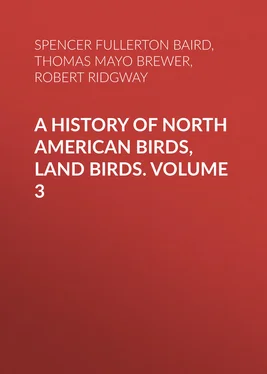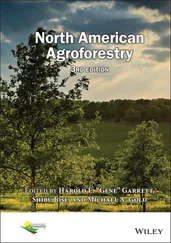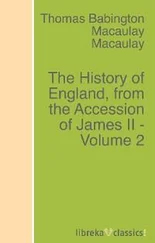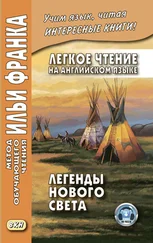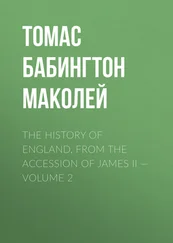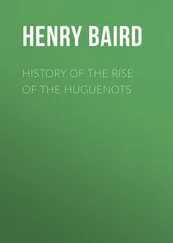Spencer Fullerton Baird - A History of North American Birds, Land Birds. Volume 3
Здесь есть возможность читать онлайн «Spencer Fullerton Baird - A History of North American Birds, Land Birds. Volume 3» — ознакомительный отрывок электронной книги совершенно бесплатно, а после прочтения отрывка купить полную версию. В некоторых случаях можно слушать аудио, скачать через торрент в формате fb2 и присутствует краткое содержание. Жанр: foreign_antique, Биология, foreign_edu, на английском языке. Описание произведения, (предисловие) а так же отзывы посетителей доступны на портале библиотеки ЛибКат.
- Название:A History of North American Birds, Land Birds. Volume 3
- Автор:
- Жанр:
- Год:неизвестен
- ISBN:нет данных
- Рейтинг книги:5 / 5. Голосов: 1
-
Избранное:Добавить в избранное
- Отзывы:
-
Ваша оценка:
- 100
- 1
- 2
- 3
- 4
- 5
A History of North American Birds, Land Birds. Volume 3: краткое содержание, описание и аннотация
Предлагаем к чтению аннотацию, описание, краткое содержание или предисловие (зависит от того, что написал сам автор книги «A History of North American Birds, Land Birds. Volume 3»). Если вы не нашли необходимую информацию о книге — напишите в комментариях, мы постараемся отыскать её.
A History of North American Birds, Land Birds. Volume 3 — читать онлайн ознакомительный отрывок
Ниже представлен текст книги, разбитый по страницам. Система сохранения места последней прочитанной страницы, позволяет с удобством читать онлайн бесплатно книгу «A History of North American Birds, Land Birds. Volume 3», без необходимости каждый раз заново искать на чём Вы остановились. Поставьте закладку, и сможете в любой момент перейти на страницу, на которой закончили чтение.
Интервал:
Закладка:
2. S. nebulosum.Lower parts striped longitudinally. Head and neck with transverse bars.
Colors reddish-umber and ochraceous-white. Face with obscure concentric rings of darker. Wing, 13.00–14.00; tail, 9.00–10.00. Hab. Eastern region of United States … var. nebulosum .
Colors blackish-sepia and clear white. Face without any darker concentric rings. Wing, 14.80; tail, 9.00. Hab. Eastern Mexico (Mirador) … var. sartorii . 21
Colors tawny-brown and bright fulvous. Face without darker concentric rings (?). Wing, 12.50, 12.75; tail, 7.30, 8.50. Hab. Guatemala … var. fulvescens . 22
3. S. occidentale.Lower parts transversely barred. Head and neck with roundish spots. Wing, 12.00–13.10; tail, 9.00. Hab. Southern California (Fort Tejon, Xantus) and Arizona (Tucson, Nov. 7, Bendire).
Strix cinerea , Gmel. Syst. Nat. p. 291, 1788.—Lath. Ind. Orn. p. 58, 1790; Syn. I, 134; Supp. I, 45; Gen. Hist. I, 337.—Vieill. Nouv. Dict. Hist. Nat. VII, 23, 1816; Enc. Méth. III, 1289; Ois. Am. Sept. I, 48.—Rich. & Swains. F. B. A. II, pl. xxxi, 1831.—Bonap. Ann. Lyc. N. Y. II, 436; Isis, 1832, p. 1140.—Aud. Birds Am. pl. cccli, 1831; Orn. Biog. IV, 364.—Nutt. Man. p. 128.—Tyzenhauz, Rev. Zoöl. 1851, p. 571. Syrnium cinereum , Aud. Synop. p. 26, 1839.—Cass. Birds Cal. & Tex. p. 184, 1854; Birds N. Am. 1858, p. 56.—Brew. (Wils.) Am. Orn. p. 687.—De Kay, Zoöl. N. Y. II, 26, pl. xiii, f. 29, 1844.—Strickl. Orn. Syn. I, 188, 1855.—Newb. P. R. R. Rept. VI, iv, 77, 1857.—Coop. & Suck. P. R. R. Rept. XII, ii, 156, 1860.—Kaup, Tr. Zoöl. Soc. IV, 1859, 256.—Dall & Bannister, Tr. Chicago Acad. I, 1869, 173.—Gray, Hand List, I, 48, 1869.—Maynard, Birds Eastern Mass., 1870, 130.— Scotiaptex cinerea , Swains. Classif. Birds, II, 217, 1837. Syrnium lapponicum , var. cinereum , Coues, Key, 1872, 204. Strix acclamator , Bart. Trans. 285, 1792.
Sp. Char. Adult. Ground-color of the upper surface dark vandyke-brown, but this relieved by a transverse mottling (on the edges of the feathers) of white, the medial portions of the feathers being scarcely variegated, causing an appearance of obsolete longitudinal dark stripes, these most conspicuous on the scapulars and back. The anterior portions above are more regularly barred transversely; the white bars interrupted, however, by the brown medial stripe. On the rump and upper tail-coverts the mottling is more profuse, causing a grayish appearance. On the wing-coverts the outer webs are most variegated by the white mottling. The alula and primary coverts have very obsolete bands of paler; the secondaries are crossed by nine (last terminal, and three concealed by coverts) bands of pale grayish-brown, inclining to white at the borders of the spots; primaries crossed by nine transverse series of quadrate spots of mottled pale brownish-gray on the outer webs, those beyond the emargination obscure,—the terminal crescentic bar distinct, however; upper secondaries and middle tail-feathers with coarse transverse mottling, almost forming bars. Tail with about nine paler bands, these merely marked off by parallel, nearly white bars, enclosing a plain grayish-brown, sometimes slightly mottled space, just perceptibly darker than the ground-color; basally the feathers become profusely mottled, so that the bands are confused; the last band is terminal. Beneath with the ground-color grayish-white, each feather of the neck, breast, and abdomen with a broad, longitudinal ragged stripe of dark brown, like the ground-color of the upper parts; sides, flanks, crissum, and lower tail-coverts with regular transverse narrow bands; legs with finer, more irregular, transverse bars of dusky. “Eyebrows,” lores, and chin grayish-white, a dusky space at anterior angle of the eye; face grayish-white, with distinct concentric semicircles of blackish-brown; facial circle dark brown, becoming white across the foreneck, where it is divided medially by a spot of brownish-black, covering the throat.
♂ (32,306, Moose Factory, Hudson Bay Territory; J. McKenzie). Wing-formula, 4=5, 3, 6–2, 7–8–9, 1. Wing, 16.00; tail, 11.00; culmen, 1.00; tarsus, 2.30; middle toe, 1.50.
♀ (54,358, Nulato, R. Am., April 11, 1868; W. H. Dall). Wing-formula, 4=5, 3, 6–2, 7–8–9, 1. Wing, 18.00; tail, 12.50; culmen, 1.00; tarsus, 2.20; middle toe, 1.70.
Hab. Arctic America (resident in Canada?). In winter extending into northern borders of United States (Massachusetts, Maynard).
The relationship between the Syrnium cinereum and the S. lapponicum is exactly parallel to that between the Otus vulgaris , var. wilsonianus , and var. vulgaris , Surnia ulula , var. hudsonia , and the var. ulula , and Nyctale tengmalmi , var. richardsoni , and the var. tengmalmi . In conformity to the general rule among the species which belong to the two continents, the American race of the present bird is very decidedly darker than the European one, which has the whitish mottling much more prevalent, giving the plumage a lighter and more grayish aspect. The white predominates on the outer webs of the scapulars. On the head and neck the white equals the dusky in extent, while on the lower parts it largely prevails. The longitudinal stripes of the dorsal region are much more conspicuous in lapponicum than in cinereum .
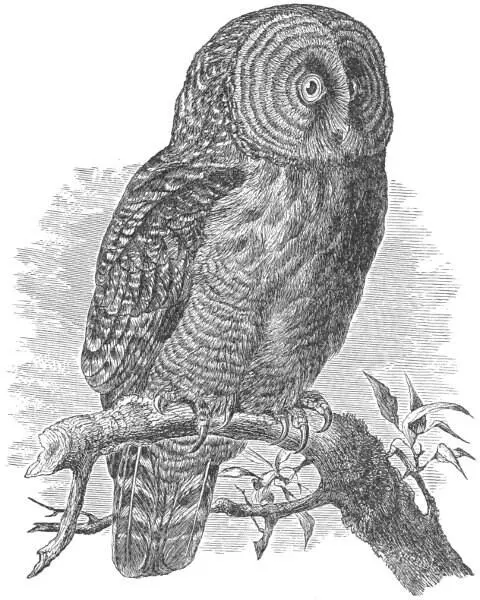
Syrnium cinereum.
A specimen in the Schlütter collection, labelled as from “Nord-Europa,” is not distinguishable from North American examples, and is so very unlike the usual Lapland style that we doubt its being a European specimen at all.
Habits. The Great Gray or Cinereous Owl appears to be confined to the more northern portions of North America. It is rarely met with in any part of the United States, and only in winter, with the exception of Washington Territory, where it is presumed to be a resident. It is also said to be a resident in Canada, and to be found in the vicinity of Montreal. Mr. Lawrence does not include this bird in his list of the birds of New York, but Mr. Turnbull states that several have been taken as far south as New Jersey. Throughout New England it is occasional in the winter, but comparatively rare. Mr. Allen did not hear of any having been taken near Springfield. On the coast of Massachusetts they are of infrequent occurrence, and are held at high prices. A fine specimen was shot in Lynn in the winter of 1872, and is now in the collection of my nephew, W. S. Brewer. On the Pacific coast it is resident as far south as the mouth of the Columbia, and is found in winter in Northern California.
Dr. Richardson met with this Owl in the fur regions, where it seemed to be by no means rare. He mentions it as an inhabitant of all the wooded districts which lie between Lake Superior and latitude 67° and 68°, and between Hudson’s Bay and the Pacific. It was common on the borders of Great Bear Lake, in which region, as well as in a higher parallel of latitude, it pursues its prey during the summer months by daylight. It was observed to keep constantly within the woods, and was not seen to frequent the barren grounds, in the manner of the Snowy Owl, nor was it so often met with in broad daylight as the Hawk Owl, apparently preferring to hunt when the sun was low and the recesses of the woods deeply shadowed, when the hares and other smaller quadrupeds, upon which it chiefly feeds, were most abundant.
On the 23d of May, Dr. Richardson discovered a nest of this Owl, built on the top of a lofty balsam-poplar, composed of sticks, with a lining of feathers. It contained three young birds, covered with a whitish down, to secure which it was necessary to cut down the tree. While this was going on, the parent birds flew in circles around the tree, keeping out of gun-shot, and apparently undisturbed by the light. The young birds were kept alive for several weeks, but finally escaped. They had the habit, when any one entered the room in which they were kept, of throwing themselves back and making a loud snapping noise with their bills.
Читать дальшеИнтервал:
Закладка:
Похожие книги на «A History of North American Birds, Land Birds. Volume 3»
Представляем Вашему вниманию похожие книги на «A History of North American Birds, Land Birds. Volume 3» списком для выбора. Мы отобрали схожую по названию и смыслу литературу в надежде предоставить читателям больше вариантов отыскать новые, интересные, ещё непрочитанные произведения.
Обсуждение, отзывы о книге «A History of North American Birds, Land Birds. Volume 3» и просто собственные мнения читателей. Оставьте ваши комментарии, напишите, что Вы думаете о произведении, его смысле или главных героях. Укажите что конкретно понравилось, а что нет, и почему Вы так считаете.
